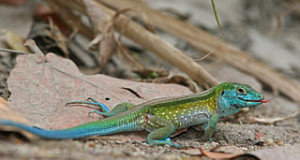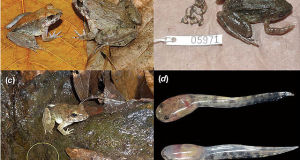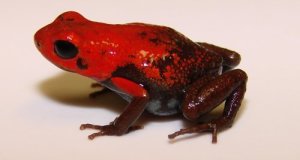A newly discovered bacteria species (Deviriesea agamarum) is responsible for a variety of fatal organ diseases that currently plague captive lizard populations, according to an article in the September, 2008 issue of The International Journal of Systematic and Evolutionary Microbiology. Particularly hard-hit has been a breeding program for the highly endangered Oman dab lizard, Uromastyx thomasi, but a number of other desert-dwelling lizards in the genera Uromastyx and Agama are susceptible as well. The bacterium is related to others that cause human skin infections.The identification of the bacterium has important implications not only for the treatment of disease in captive lizards, but also for wild populations. Captive-bred reptiles that are used in reintroduction programs may appear healthy but harbor diseases that can decimate wild populations. Some years ago, this very situation caused serious respiratory disease outbreaks among desert tortoise populations in the American southwest, and led to a ban on the release of confiscated tortoises. Similarly, the September 23, 2008 issue of Current Biology states that many amphibian species in Europe are currently threatened by a fatal Chytrid fungus that was introduced to the wild by Mallorcan midwife toads released as part of a reintroduction effort.
You can read more about disease problems that affect reintroduction programs at:
http://esciencenews.com/articles/2008/09/22/captive.breeding.introduced.infectious.disease.mallorcan.amphibians.0
 That Reptile Blog – Reptile, Amphibian and Exotic Pet Care and Information
That Reptile Blog – Reptile, Amphibian and Exotic Pet Care and Information




Frank, thank you for the article! I have a Mali Uro’ and I have a son with special needs…..is there any thing I should be doing aside from hand washing to prevent the bacterial infections? Also I house my Uro’ in a 100 gal tank and I have a young child who sleeps in the same room…are there concerns with the air quality with reptiles? I clean out the tank daily, and he has celci’ sand for tank flooring. I do not bring the Uromastyx out around the baby but my son frequently handles him
Hello Michaelle,
Thanks for the kind words and glad you enjoyed. The most common concern is Salmonella, but there are other types of micro-organisms associated with reptiles that may be problematical in some situations. Surface disinfection, sink in which animal-related items are cleaned etc must also be considered, as well as your child’s specific condition or needs. I always advise folks to appraise their medical doctor of all details re care, cleaning etc. and to ask for specific instructions. The following article covers the basics, and has a link to the US Center for Disease Control recommendations, but should not be used in place of a doctor’s advice: http://blogs.thatpetplace.com/thatreptileblog/2012/04/04/salmonella-prevention-guidelines-for-reptile-and-amphibian-owners/
Uromastyx are fascinating lizards, but they can be delicate if their specific needs are not met. Assuming you’re providing adequate heat, a 100 gallon tank is ideal, as it allows for a thermal gradient…areas of varying temperatures. The articles linked below provide general info…please let me know if you need anything more detailed. Best regards, Frank
http://blogs.thatpetplace.com/thatreptileblog/2010/04/09/spiny-tailed-agamids-the-fascinating-lizards-of-the-genus-uromastyx-part-1/
http://blogs.thatpetplace.com/thatreptileblog/2010/04/21/spiny-tailed-agamids-the-fascinating-lizards-of-the-genus-uromastyx-part/